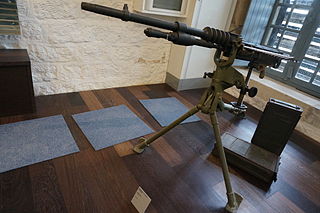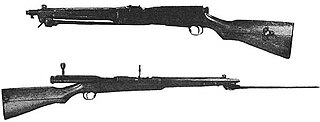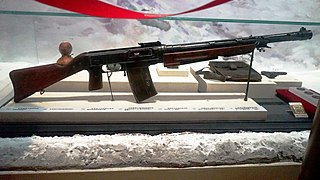
The National Revolutionary Army, sometimes shortened to Revolutionary Army (革命軍) before 1928, and as National Army (國軍) after 1928, was the military arm of the Kuomintang from 1925 until 1947 in China. It also became the regular army of the Republican era during the KMT's period of party rule beginning in 1928. It was renamed the Republic of China Armed Forces after the 1947 Constitution, which instituted civilian control of the military.

The Type 3 heavy machine gun, also known as the Taishō 14 machine gun, was a Japanese air-cooled heavy machine gun. The Type 3 heavy machine gun was in a long-line of Japanese Hotchkiss machine gun variants that the Imperial Japanese Army would utilize from 1901 to 1945.

The Mle 1914 Hotchkiss machine gun chambered for the 8mm Lebel cartridge became the standard machine gun of the French Army during the latter half of World War I. It was manufactured by the French arms company Hotchkiss et Cie, which had been established in the 1860s by American industrialist Benjamin B. Hotchkiss. The gas-actuated Hotchkiss system was first formulated in 1893 by Odkolek von Ujezda and improved into its final form by Hotchkiss armament engineers, American Laurence Benét and his French assistant Henri Mercié.

The Type 11 light machine gun was a light machine gun used by the Imperial Japanese Army in the interwar period and during World War II. Adopted as the Imperial Japanese Army's first light machine gun, the Type 11 was designed by Kijirō Nambu and had certain similarities to the Hotchkiss series of machine guns. It had an unusual feed system which required five round clips to be dropped into a hopper, this held up to a total of six clips and each round was oiled as it was fed into the chamber. Despite good overall performance, this feed system was prone to collect dirt and grit which would jam the weapon while in use. It was issued to troops in 1922 and saw extensive service as a squad weapon until 1945.

The Type 38 rifle is a bolt-action service rifle that was used by the Empire of Japan predominantly during the Second Sino-Japanese War and Second World War. The design was adopted by the Imperial Japanese Army in 1905. Due to a lack of power in its 6.5×50mmSR Arisaka cartridge, it was partially replaced during the war with the Type 99 rifle, but both rifles saw usage until the end of the war.

The Type 44 cavalry rifle is a Japanese bolt-action rifle. This rifle is also often referred to as a Type 44 carbine. The Type 44 is sometimes confused with the Type 38 carbine, since both were based on the Type 38 service rifle. Designed in 1911 by Arisaka Nariakira, it is a carbine intended for cavalry troops. It had a fixed bayonet and was first issued before the First World War. It was produced in large numbers and was still in production in the early years of World War Two.
The vz. 24 rifle is a bolt-action carbine designed and produced in Czechoslovakia from 1924 to 1942. It was developed from the German Mauser Gewehr 98 line, and features a very similar bolt design. The rifle was designed in Czechoslovakia shortly after World War I, to replace the Vz. 98/22, also a Czech-designed derivative of the Gewehr 98. The vz. 24 featured a 590 mm (23.2 in) barrel which was shorter and considered more handy than the 740 mm (29.1 in) Gewehr 98 barrel. The vz. 24 was chambered in 7.92×57mm Mauser like its predecessors.

The ZB vz. 26 was a Czechoslovak light machine gun developed in the 1920s, which went on to enter service with several countries. It saw its major use during World War II, and spawned the related ZB vz. 27, vz. 30, and vz. 33. The ZB vz. 26 influenced many other light machine gun designs including the British Bren light machine gun and the Japanese Type 97 heavy tank machine gun. The ZB-26 is famous for its reliability, simple components, quick-change barrel and ease of manufacturing. This light machine gun in the Czechoslovak army was marked as the LK vz. 26. ZB vz. 26 is incorrect nomenclature because "ZB-26" is a factory designation, while "vzor 26" or "vz. 26" is an army designation.

The Type 30 rifleArisaka is a box-fed bolt-action repeating rifle that was the standard infantry rifle of the Imperial Japanese Army from 1897 to 1905.

The Madsen is a light machine gun that Julius A. Rasmussen and Theodor Schouboe designed and proposed for adoption by Colonel Vilhelm Herman Oluf Madsen, the Danish Minister of War, and that the Royal Danish Army adopted in 1902. It was the world's first true light machine gun produced in quantity and Madsen was able to sell it in 12 calibres to over 34 countries. The gun saw extensive combat usage for over 100 years, with continued use in limited quantities worldwide into the 2010s. The Madsen was produced by Compagnie Madsen A/S.

The ZB-30 and ZB-30J were Czechoslovakian light machine guns that saw extensive use during World War II.

The Type 88, sometimes known as "Hanyang 88" or Hanyang Type 88 and Hanyang Zao, is a Chinese-made bolt-action rifle, based on the German Gewehr 88. It was adopted by the Qing Dynasty towards the end of the 19th century and was used by multiple factions and formations like those in the Republic of China, until the end of the Chinese Civil War.
The Type Chiang Kai-shek rifle, also known as the Generalissimo rifle, and Type 24 (二四式), named after the Chinese Generalissimo Chiang Kai-shek, was a Chinese-made copy of the German Standardmodell rifle, the forerunner of the Karabiner 98k. Preproduction of the Chiang Kai-shek rifle started in 1935. It was designated the Type 79 by the Chinese Communists.

The Hotchkiss M1922 was a light machine gun manufactured by Hotchkiss.

The FN Model 1924 series is a line of Mauser Gewehr 98 pattern bolt-action rifles produced by the Belgian Fabrique Nationale. They are similar to the Czech vz. 24 rifle, however have an intermediate length action, featuring open sights, 7.65×53mm, 7×57mm or 8×57mm IS chambering, Long rifle, Short Rifle and carbine-length barrels, hardwood stocks, and straight or curved bolt handles. This pattern rifle was discontinued from production and was no longer offered after 1932 being totally replaced by the 1930 pattern.

The SIG KE7 is a light machine gun designed and manufactured in Switzerland in the decade before the Second World War. Although exported, it was never used by the Swiss Army.
The Mukden Arsenal Mauser also known as the Model 13 Mauser and Liao Type 13 was a rifle that implemented characteristics of both the Mauser Type 4 and the Arisaka rifles. They were mostly built in the Mukden arsenal in Manchukuo.
The Mauser Model 1904 and Model 1907 were Gewehr 98 pattern bolt-action rifles produced by Mauser and Deutsche Waffen und Munitionsfabriken (DWM). They were designed for export market. Copies were later produced in China and in Spain.
The Standardmodell rifle is a bolt-action rifle designed to chamber the 7.92×57mm Mauser cartridge. The rifle was developed in 1924 but entered full-scale production in 1933. Officially designed for export and German security guards, it was used by the paramilitary Sturmabteilung (SA) and Schutzstaffel (SS). Export variants were used in South America, Ethiopia, China and the Iberian Peninsula. The carbine version of this rifle was almost identical with the Karabiner 98k that became the standard German service rifle during World War II.













